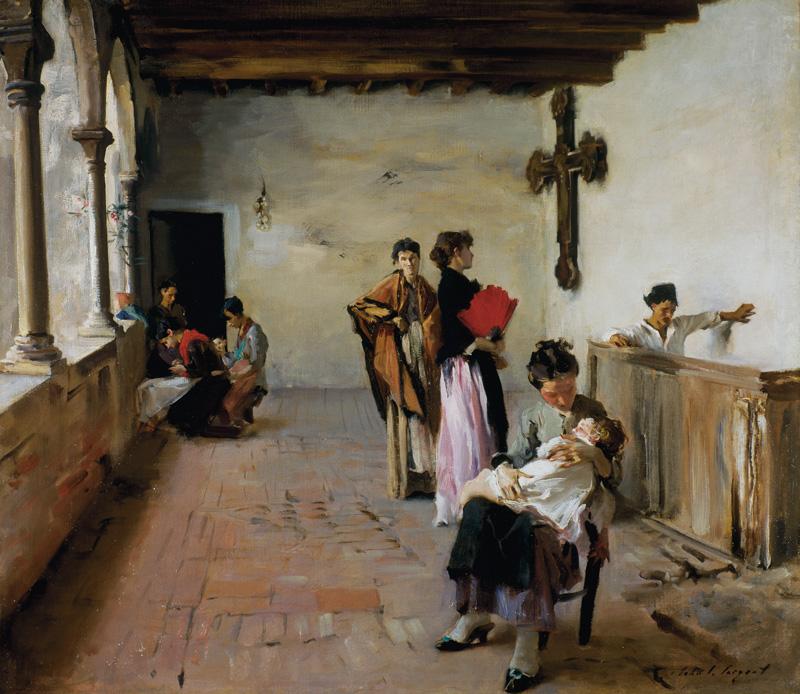 |
 |
|
c. 1882 Collection of Mrs. John Hay Whitney Oil on canvas 71.7 by 80.6 cm (27 1/2 x 31 3/4 in.) signed lr: John S. Sargent Jpg:Sothebys From: Sothebys Venetian Loggia was painted during the years 1880-82, an intensely fertile period for Sargent—a time of extensive travel and the search for new and exotic subject matter, when the confluence of fresh experiences and varied stimuli fed the artist’s creative senses and led to some of his most visually intriguing and original works. . . . The artist was content to return home with a large quantity of interior views and street scenes, which he proceeded to exhibit widely at avant-garde venues, linking him firmly with the latest trends in French painting" (John Singer Sargent, London, 1998, p. 26-27). Stylistically and technically, Venetian Loggia belongs to the extraordinary series of pictures of Italian women stringing beads or strolling leisurely in the courtyards of old palazzi Sargent painted during his two Venetian sojourns and has been dated by scholars to circa 1880-1882. In the present picture, a young woman, seen in profile and holding a red fan, strongly resembles the models who appear in a number of Sargent’s best-known works including Venetian Bead Stringers, (figure 1). The majority of these Italian paintings also share compositional elements, such as the artist’s treatment of space, steep recession and unconventional cropping, all of which are evident in the two Venetian interiors in the collections of the Sterling and Francine Clark Art Insitute (figure 2) and the Carnegie Museum of Art (figure 3). A luminous palette of rich whites, grays and black dominates Venetian Loggia, creating a sense of mystery and exoticism that is punctuated by the intense accents of red and pink scattered throughout the composition. A golden light radiates through the arched arcade on the left, highlighting the red flower buds in the open archway, the scarf of the woman sewing and the deep red of the young woman’s fan. The contrasting tonalities of light and dark found in the richly painted black areas of the model’s shawl and the open doorway silhouetted against the lighter hues of the background reveal the impact and continuing assimilation of Sargent’s close study of Velázquez, whose paintings Sargent had copied at the Prado in Spain a few years earlier. While Sargent defines the figures and their surroundings with confident strokes of pigment and broad areas of color, the lack of interaction between the sitters and the quietness of their poses imbue the courtyard with a sense of intimacy and mystery. The precise location and title of the painting have been a subject of some conjecture over the years. The painting was widely exhibited during Sargent’s lifetime, first in 1898 in New York at the Society of American Art as Spanish Cloister, and early the following year at the Pennsylvania Academy of the Fine Arts as Spanish Interior. In February 1899 the painting was shown at Copley Hall in Boston as Spanish Courtyard, a title that remained with the work during exhibitions at the Panama-Pacific International Exposition in San Francisco in 1915, and at both of the Sargent Memorial Exhibitions, first in Boston at the Museum of Fine Arts in 1925 and then at the Metropolitan Museum of Art in New York in 1926. The painting was not exhibited publicly again until 1961, when the Whitney Collection was shown at the Tate Gallery in London, again with the title Spanish Courtyard. The early Sargent literature also reflects this title, with William Howe Downes (1925) and Evan Charteris (1927) both referring to the painting as Spanish Courtyard. Then, in 1957, Charles Merrill Mount titled the picture Venetian Courtyard, a title that stayed with the painting in the subsequent literature, including Richard Ormond (1970) and Marc Simpson (1997). When the The John Hay Whitney Collection was exhibited at the National Gallery of Art in Washington D.C. in 1983, the painting was included with the title Venetian Courtyard. The picture’s provenance sheds a bit of light on the subject, but is not in itself conclusive. The American-born Louis B. McCagg, a non-practicing lawyer and man about town, purchased the painting from Sargent circa 1884 and while it is presumed that the title came directly from the artist, Richard Ormond suggests that possibly either McCagg or the artist misremembered the location. Interestingly, McCagg owned another painting by Sargent, a small study entitled Spanish Gypsy Dancer (figure 5). The two pictures were included together in the 1898 exhibition at the Society of American Artists, and in the Panama-Pacific International exhibition in 1915. This painting will be
included in
a forthcoming volume of the J.S. Sargent catalogue raisonné by
Richard
Ormond and Elaine Kilmurray, in collaboration with Warren Adelson and
Elizabeth
Oustinoff. Notes: Provenance Louis Butler McCagg,
circa 1884 (acquired
from the artist) Exhibitions New York, Society of
American Artists,
March-April 1898, no. 293 (as Spanish Cloister) Bibliography Frank Jewett Mather,
"Estimates in
Art: Series II," New York, 1931, p. 240 Sale Sold at Sothebys, New
York, 19 May
04, Session 1, 10:15 AM, Sale N07997
|

By:
Natasha
Wallace
Copyright 1998-2004 all rights reserved
Created 3/24/2004